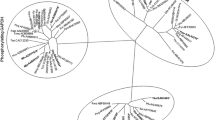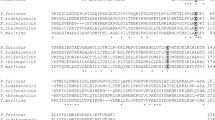Abstract
A glycerate kinase gene (ST2037) from the hyperthermophilic crenarchaeon Sulfolobus tokodaii was cloned and expressed in Escherichia coli. The purified homodimeric protein (45 kDa) specifically catalyzed the formation of 2-phosphoglycerate with d-glycerate as substrate. The thermostable enzyme displayed maximum activity (over 20 min) at 90°C and pH 4.5. The maximal activity was in the presence of Co2+. The MOFRL family glycerate kinase used AMP as phosphate donor with maximal activity towards GTP. These characteristics of the enzyme suggested its potential in the catalytic production of 2-phosphoglycerate.


Similar content being viewed by others
References
Brock TD, Brock KM, Belly RT, Weiss RL (1972) Sulfolobus: a new genus of sulfur-oxidizing bacteria living at low pH and high temperature. Arch Mikrobiol 84:54–68
Egorova K, Antranikian G (2005) Industry relevance of thermophilic archaea. Curr Opin Microbiol 8:1–7
Kehrer D, Ahmed H, Brinkmann H, Siebers B (2007) Glycerate kinase of the hyperthermophilic archaeon Thermoproteus tenax: new insights into the phylogenetic distribution and physiological role of members of the three different glycerate kinase classes. BMC Genomics 8:301
Liu B, Hong Y, Wu L, Li Z, Ni J, Sheng D, Shen Y (2007) A unique highly thermostable 2-phosphoglycerate forming glycerate kinase from the hyperthermophilic archaeon Pyrococcus horikoshii: gene cloning, expression and characterization. Extremophiles 11:733–739
Noh M, Jung JH, Lee SB (2006) Purification and characterization of glycerate kinase from the thermoacidophilic archaeon Thermoplasma acidophilum: an enzyme belonging to the second glycerate kinase family. Biotechnol Bioprocess Eng 11:344–350
Reher M, Bott M, Schönheit P (2006) Characterization of glycerate kinase (2-phosphoglycerate forming), a key enzyme of the nonphosphorylative Entner–Doudoro pathway, from the thermoacidophilic euryarchaeon Picrophilus torridus. FEMS Microbiol Lett 259:113–119
She Q, Singh RK, Confalonieri F et al (2004) The complete genome of the crenarchaeon Sulfolobus solfataricus P2. Proc Natl Acad Sci USA 98:7835–7840
Siebers B, Schönheit P (2005) Unusual pathways and enzymes of central carbohydrate metabolism in Archaea. Curr Opin Microbiol 8:695–705
Sims PA, Reed GH (2005) Method for the enzymatic synthesis of 2-phospho-d-glycerate from adenosine 5′-triphosphate and d-glycerate via d-glycerate-2-kinase. J Mol Catal B 32:77–81
Yamagishi A, Oshima T (1990) Circular chromosomal DNA in the sulfur-dependent archaebacterium Sulfolobus acidocaldarius. Nucleic Acids Res 18:1133–1136
Yang C, Rodionov DA, Rodionova IA, Li X, Osterman AL (2008) Glycerate 2-kinase of Thermotoga maritima and genomic reconstruction of related metabolic pathways. J Bacteriol 190:1773–1782
Acknowledgements
This work was supported by grants from the National Basic Research Program (2004CB719604) and the State Key Laboratory of Microbial Technology of China.
Author information
Authors and Affiliations
Corresponding author
Electronic supplementary material
Below is the link to the electronic supplementary material.
10529_2009_89_MOESM1_ESM.docx
Supplementary Fig. 1 Alignment of the amino acid sequences of S. tokodaii GK with some of its homologous proteins. Numbering of the amino acids is indicated on the right. Conserved residues are indicated by an asterisk above the alignment, single and double dots represent amino acids with semi-conservative and conservative substitutions. Gaps are indicated as dashes. The residues of conserved glycine rich loop are underlined in bold. The MOFRL domain of GKPh is underlined. Seven conserved amino acids of the presumed active site are boxed. Sto S. tokodaii, Mse M. sedula, Cma C. Maquilingensis, Pho P. horikoshii, Tte T. tenax, Tma Thermotoga maritima. Accession numbers for these sequences are stated in “Sequence and primary structure features” in Results (DOCX 147 kb)
Rights and permissions
About this article
Cite this article
Liu, B., Wu, L., Liu, T. et al. A MOFRL family glycerate kinase from the thermophilic crenarchaeon, Sulfolobus tokodaii, with unique enzymatic properties. Biotechnol Lett 31, 1937–1941 (2009). https://doi.org/10.1007/s10529-009-0089-z
Received:
Revised:
Accepted:
Published:
Issue Date:
DOI: https://doi.org/10.1007/s10529-009-0089-z




